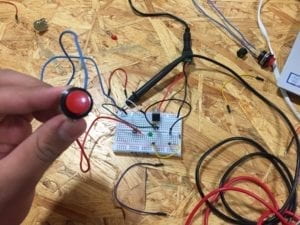For this week’s recitation, we learnt how to solder and assembled 3 different circuits: a doorbell, a lamp and a dimmable lamp. The circuits were housed in a breadboard, which allowed us to connect the different components without soldering them together, with the aid of jumper cables.
First Circuit: Doorbell
It consisted of a 12v power adapter, which would be plugged in to supply the circuit with power, connected to a speaker through a transistor, which supplied the speaker with the correct voltage. The speaker was connected to a switch, which would interrupt and restart the circuit when pressed, and then to ground. The transistor was also connected to ground, and closed the circuit by connecting again to the power adaptor through a capacitor, which stored and released energy depending on the state of the circuit.
Second Circuit: lamp
It consisted of a similar circuit to that of the doorbell, the difference being an LED instead of the speaker, and a 220 Ohm resistor in between the transistor and LED in order to regulate the current flowing into the LED. We used the button we soldered at the beginning of the class.

Third Circuit: Dimmable Lamp
A potentiometer was added in between the 220 Ohm resistor and the LED in order for us to be able to vary the amount of current that passed through the LED, thus allowing us to regulate its intensity.
Questions
- In the case of all the three circuits, the interaction is between us and the circuit. We tell the circuit, by pressing the button on the switch or turning the potentiometer’s knob, that we want to either hear the buzzer or see the LED light up, and by releasing the button we are telling the circuit that we don’t want to see or hear what the circuit produces anymore.
- Interaction design and physical computing can be used to create interactive art in different ways. One example is the one we saw in Zack Liberman’s video, when he made a pair of glasses that allowed a person with ALS to draw graffiti. The point of Liberman’s device was that anyone should be able to produce art, no matter how deteriorated their health is, there is almost always some part of the body that could move or emit a signal that a sensor could sense and translate into a visual or auditive outcome. I saw and interacted with an example of production of interactive art a few years ago when I went to EPCOT, in Florida, and saw a game in which the user had to stand and move their hands, and based on the position of their hands, a dragon that was projected on the screen would move and play different notes.